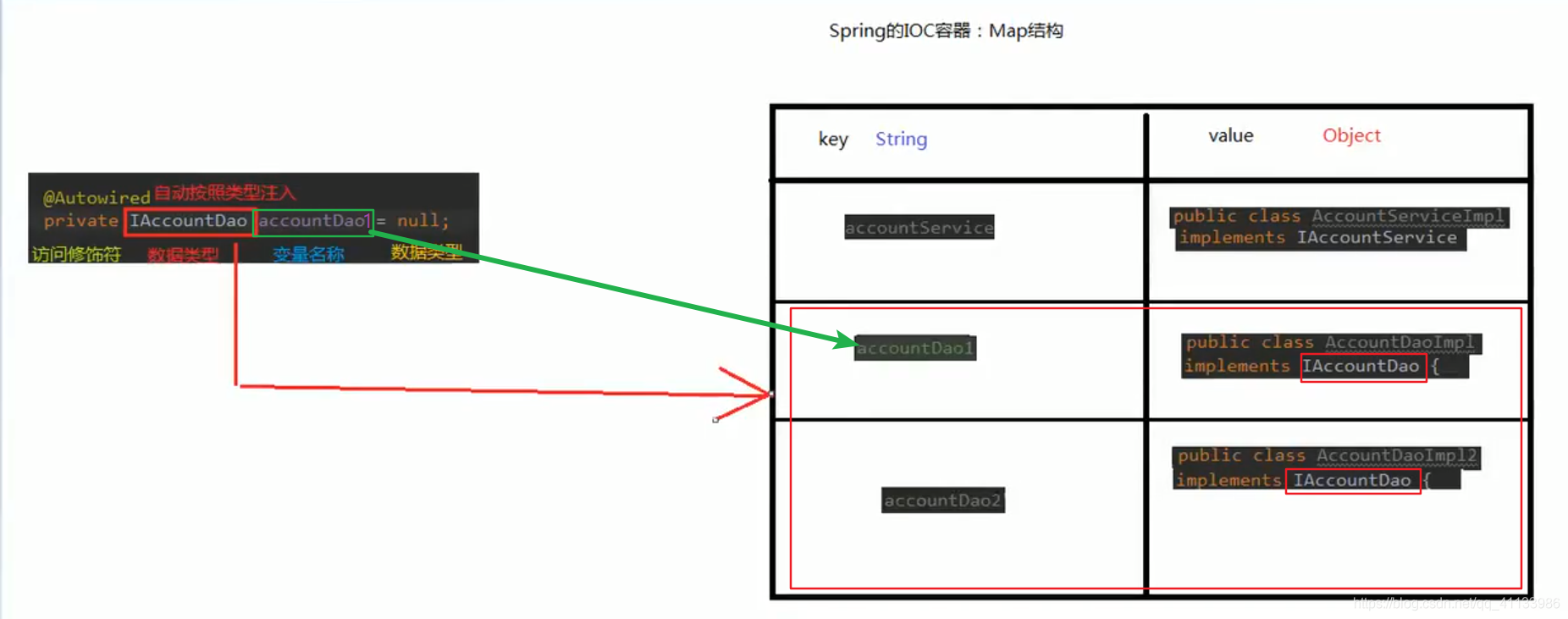系列博客:
注解配置和 xml 配置要实现的功能都是一样 的,都是要降低程序间的耦合。只是配置的形式不一样。
回顾以下基于Xml的 IoC 配置
<bean id = "accountService" class = "com.smallbeef.service.impl.AccountServiceImpl"
scoper = "" init-method = "" destory-method = "">
<property name = "" / ref = "">
</bean>
文章目录
一、Spring 中 IoC 的常用注解
XML配置自动化扫描
<?xml version="1.0" encoding="UTF-8"?>
<beans xmlns="http://www.springframework.org/schema/beans"
xmlns:context="http://www.springframework.org/schema/context"
xmlns:xsi="http://www.w3.org/2001/XMLSchema-instance"
xsi:schemaLocation="http://www.springframework.org/schema/beans
http://www.springframework.org/schema/beans/spring-beans.xsd
http://www.springframework.org/schema/context
http://www.springframework.org/schema/context/spring-context.xsd">
<!--告知Spirng在创建容器时要扫描的包,配置所需要的标签不是在beans的约束中,而是一个名称为context空间和约束中-->
<context:component-scan base-package="com.smallbeef"></context:component-scan>
</beans>
1. 用于创建对象的
他们的作用和 XML 配置文件中编写一个 bean 标签实现的功能是一样的
@Component
作用:用于把当前类对象存入 Spring 容器中
属性:
value: 用于指定 bean 的 id 。当我们不写时,他的默认值是当前类名,且首字母小写。
// 没有写value 默认值accountServiceImpl
@Component
public class AccountServiceImpl implements IAccountService {
}
public class Client {
public static void main(String[] args) {
ApplicationContext ac = new ClassPathXmlApplicationContext("bean.xml");
IAccountService as = (IAccountService) ac.getBean("accountServiceImpl");
System.out.println(as);
}
}
@Controller / @Service / @Repository
这三个注解的作用和属性与Component是一摸一样的,四个注解可以随意互换
他们只不过是提供了更加明确的语义化。
@Controller:一般用于表现层的注解。@Service:一般用于业务层的注解。@Repository:一般用于持久层的注解。
2. 用于注入数据的
他们的作用和在 XML 配置文件的 bean 标签中编写一个 property 标签实现的功能是一样的(set方法注入)
@Autowired
作用: 自动按照类型注入。
出现位置:变量和方法上都可以
当使用注解注入属性时,set方法可以省略。
它只能注入其他 bean 类型。
在 Spring 容器查找,找到了注入成功。找不到 就报错。
当有多个 类型匹配时,使用 要注入的对象变量名称 作为 bean 的 id
@Repository
public class AccountDaoImpl1 implements IAccountDao {
public void saveAccount(){
System.out.println("保存了账户");
}
}
__________________________________________________________________________
@Repository
public class AccountDaoImpl2 implements IAccountDao {
public void saveAccount(){
System.out.println("222保存了账户");
}
}
@Component
public class AccountServiceImpl implements IAccountService {
@Autowired
// private IAccountDao accountDaoImpl1;
private IAccountDao accountDaoImpl2;
@Override
public void saveAccount() {
accountDaoImpl2.saveAccount();
}
}
public class Client {
/**
* 获取spring的Ioc容器,并根据id获取对象
* @param args
*/
public static void main(String[] args) {
ApplicationContext ac = new ClassPathXmlApplicationContext("bean.xml");
IAccountService as = (IAccountService) ac.getBean("accountServiceImpl");
System.out.println(as);
as.saveAccount();
}
}
-
只有一个相符合的bean时,直接匹配数据类型

-
有多个相匹配的bean时,先匹配数据类型,再根据 变量名称 与 bean的id 进行精确匹配

当变量名称找不到一样的 bean 的 id 的时候,就会报错。
为解决变量名称和 bean 的 id 不匹配的情况,有了如下注解 Qualifier。
@Qualifier
作用: 在自动按照类型注入的基础之上,再按照 Bean 的 id 注入。
它在给成员变量注入时不能独立使用,必须和 @Autowire 一起使用;但是给方法参数注入时,可以独立使用
属性: value:指定 bean 的 id。
@Component
public class AccountServiceImpl implements IAccountService {
@Autowired
@Qualifier("accountDaoImpl1")
private IAccountDao accountDaoImpl;
@Override
public void saveAccount() {
accountDaoImpl.saveAccount();
}
}
@Resource
作用: 直接按照 Bean 的 id 注入。可以独立使用。它也只能注入其他 bean 类型。
属性: name:指定 bean 的 id。
@Component
public class AccountServiceImpl implements IAccountService {
@Resource(name = "accountDaoImpl2")
private IAccountDao accountDaoImpl;
@Override
public void saveAccount() {
accountDaoImpl.saveAccount();
}
}
以上三个注解都智能注入其他bean类型的数据,而基本类型和String类型无法使用上述注解实现(用 @Value 实现)。
另外,集合类型的注入只能通过XML来实现
@Value
作用: 注入基本数据类型和 String 类型的数据
属性: value:用于指定值。它可以使用 Spring 中 SpEL(也就是spring中的EL表达式, ${表达式})
3. 用于改变作用范围的
作用和在XML配置文件的标签中使用scope属性实现的功能是一样的
@Scope
作用: 指定 bean 的作用范围。
属性: value:指定范围的值。
取值:singleton / prototype / request / session / globalsession
4. 用于改变生命周期的 (了解即可)
他们的作用和在XML配置文件的标签中使用inti-method和destroy-method属性实现的功能是一样的
@PreDestroy
作用: 用于指定销毁方法。
@PostConstruct
作用: 用于指定初始化方法。
public class Client {
/**
* 获取spring的Ioc容器,并根据id获取对象
* @param args
*/
public static void main(String[] args) {
ClassPathXmlApplicationContext ac = new ClassPathXmlApplicationContext("bean.xml");
IAccountService as = (IAccountService) ac.getBean("accountServiceImpl");
as.saveAccount();
ac.close(); //单例模式,容器销毁,对象释放,调用destroy方法
}
}

写到此处,基于注解的 IoC 配置已经完成,但是大家都发现了一个问题:我们依然离不开 spring 的 xml 配 置文件,那么能不能不写这个 bean.xml,所有配置都用注解来实现呢?
二、Spring 的纯注解配置
我们发现,之所以我们现在离不开 xml 配置文件,是因为我们有一句很关键的配置:
<!-- 告知spring框架在,读取配置文件,创建容器时,扫描注解,依据注解创建对象,并存入容器中 -->
<context:component-scan base-package="com.smallbeef"></context:component-scan>
如果他要也能用注解配置,那么我们就离脱离 xml 文件又进了一步。
另外,数据源和 JdbcTemplate 的配置也需要靠注解来实现。
<!-- 配置 dbAssit -->
<bean id="dbAssit" class="com.smallbeef.dbassit.DBAssit">
<property name="dataSource" ref="dataSource"></property>
</bean>
<!-- 配置数据源 -->
<bean id="dataSource" class="com.mchange.v2.c3p0.ComboPooledDataSource">
<property name="driverClass" value="com.mysql.jdbc.Driver"></property>
<property name="jdbcUrl" value="jdbc:mysql:///spring_day2"></property>
<property name="user" value="root"></property>
<property name="password" value="1234"></property>
</bean>
@Configuration
作用: 用于指定当前类是一个 Spring 配置类,当创建容器时会从该类上加载注解。
获取容器时需要使用 AnnotationApplicationContext(有 @Configuration 注解的类 .class)。
属性: value:用于指定配置类的字节码
细节:当配置类作为 AnnotationConfigApplicationContext 对象创建的参数时,该配置类上的 @Configuration 注解可以不写
@ComponentScan 自动化扫描
作用: 用于指定 Spring 在初始化容器时要扫描的包。
作用和在 Spring 的 xml 配置文件中的:
<context:component-scan base-package="com.smallbeef"/> 是一样的。
属性: basePackages / value:用于指定要扫描的包。
@Configuration
@ComponentScan("com.smallbeef")
public class JDBCConfiguration {
}
使用这两个注解我们已经配置好了要扫描的包,但是数据源和 JdbcTemplate 对象如何从配置文件中移除呢?
@Bean
作用: 该注解只能写在方法上,表明把当前方法的返回值作为bean对象存入spring 容器中。
属性: name:给当前 @Bean 注解方法创建的对象指定一个名称(即 bean 的 id)。 默认值是当前方法的名称
细节:当我们使用注解配置方法时,如果方法有参数,Spring 框架会去容器中查找有没有相匹配的 bean 对象,查找方法和AutoWired一样。
/**
* 连接数据库的配置类
*/
@Configuration
@ComponentScan("com.smallbeef")
public class JDBCConfiguration {
/**
* 创建一个数据源,并存入 spring 容器中
* * @return
* */
@Bean(name="dataSource")
public DataSource createDataSource() {
try {
ComboPooledDataSource ds = new ComboPooledDataSource();
ds.setUser("root");
ds.setPassword("1234");
ds.setDriverClass("com.mysql.jdbc.Driver");
ds.setJdbcUrl("jdbc:mysql:///spring_day02");
return ds;
} catch (Exception e) {
throw new RuntimeException(e);
}
}
/**
* 创建一个 QuerryRunner对象,并且也存入 spring 容器中
* * @param dataSource
* * @return
* */
@Bean(name="dbAssit")
public DBAssit createDBAssit(DataSource dataSource) {
return new DBAssit(dataSource);
}
}
这样,我们已经把数据源和 DBAssit 从配置文件中移除了,此时可以删除 bean.xml 了。 但是由于没有了配置文件,创建数据源的配置 ClassPathXmlApplicationContext ac = new ClassPathXmlApplicationContext("bean.xml");又都写死在类中了。如何把它们配置出来呢?
如下:
ApplicationContext ac = new AnnotationConfigApplicationContext(SpringConfiguration.class);
@Import
作用: 用于导入其他配置类,有 @Import 注解的类就是主配置类.
在引入其他配置类时,其他子配置类可以不用再写 @Configuration 注解。当然,写上也没问 题。
属性: value[]:用于指定其他配置类的字节码。
大的 SpringConfiguration 类利用 @Import 包含小的 JDBCConfiguration 配置类,这样 AnnotationConfigApplicationContext 直接加载大的配置类,就会把这些小的配置类也都加载进来
@Configuration //在 AnnotationConfigApplicationContext中做参数时可以不写该注解
@ComponentScan(basePackages = "com.itheima.spring")
@Import({ JdbcConfig.class,xxxxxConfig.class, xxxxConfig.class})
public class SpringConfiguration {
}
public class JdbcConfig{
}
——————————————————————————————————————————————
ApplicationContext ac = new AnnotationConfigApplicationContext(SpringConfiguration.class);
@PropertySource
作用:用于加载 .properties 文件中的配置。例如我们配置数据源时,可以把连接数据库的信息写到 properties 配置文件中,就可以使用此注解指定 properties 配置文件的位置。
属性: value[]:用于指定 properties 文件位置。如果是在类路径下,需要写上 classpath:
可以看到以上数据库的配置是写死的
@Bean(name="dataSource")
public DataSource createDataSource() {
try {
ComboPooledDataSource ds = new ComboPooledDataSource();
ds.setUser("root");
ds.setPassword("1234");
ds.setDriverClass("com.mysql.jdbc.Driver");
ds.setJdbcUrl("jdbc:mysql:///spring_day02");
return ds;
} catch (Exception e) {
throw new RuntimeException(e);
}
}
我们将数据库配置放在 .properties 文件中,利用 @PropertySource 注解读取该文件,并用 @Value 注解传值
jdbcConfig.properties
jdbc.driver=com.mysql.jdbc.Driver
jdbc.url=jdbc:mysql://localhost:3306/day44_ee247_spring
jdbc.username=root
jdbc.password=1234
利用 @Value 取值
/**
* 连接数据库的配置类
*/
@Configuration
@ComponentScan("com.smallbeef")
public class JDBCConfiguration {
@Value("${jdbc.driver}") //与properties中属性一致
private Stirng driver;
@Value("${jdbc.url}")
private String url;
@Value("${jdbc.username}")
private String username;
@Value("${jdbc.password}")
private String password;
/**
* 创建一个数据源,并存入 spring 容器中
* * @return
* */
@Bean(name="dataSource")
public DataSource createDataSource() {
try {
ComboPooledDataSource ds = new ComboPooledDataSource();
ds.setUser("username");
ds.setPassword("password");
ds.setDriverClass("driver");
ds.setJdbcUrl("url");
return ds;
} catch (Exception e) {
throw new RuntimeException(e);
}
}
/**
* 创建一个 QuerryRunner对象,并且也存入 spring 容器中
* * @param dataSource
* * @return
* */
@Bean(name="dbAssit")
public DBAssit createDBAssit(DataSource dataSource) {
return new DBAssit(dataSource);
}
}
利用 @PropertySource 传入 properties 文件
@Configuration
@ComponentScan(basePackages = "com.smallbeef.spring")
@Import(JdbcConfig.class)
@PropertySource("classpath:jdbcConfig.properties")
public class SpringConfiguration {
}
三、Spring 整合Junit
问题:

在测试类中,每个测试方法都有以下两行代码:
ApplicationContext ac = new ClassPathXmlApplicationContext("bean.xml"); IAccountService as = ac.getBean("accountService",IAccountService.class);
这两行代码的作用是获取容器,如果不写的话,直接会提示空指针异常。所以又不能轻易删掉。
Spring整合Junit的配置步骤
- 导入 Spring 整合 junit 的 ja r包
<dependency>
<groupId>org.springframework</groupId>
<artifactId>spring-test</artifactId>
<version>5.0.2.RELEASE</version>
</dependency>
//当我们使用spring5.x版本的时候,要求junit的jar包必须是4.12及以上
<dependency>
<groupId>junit</groupId>
<artifactId>junit</artifactId>
<version>4.12</version>
</dependency>
- 使用
@RunWith替换原有的 main 方法
/**
* 测试类
*/
@RunWith(SpringJUnit4ClassRunner.class)
public class AccountServiceTest {
}
- 使用
@ContextConfiguration指定 Spring 配置文件的位置
- locations: 指定xml文件的位置,classpath 表示在类路径下
- classes:指定注解类所在位置
/**
* 测试类
*/
@RunWith(SpringJUnit4ClassRunner.class)
// @ContextConfiguration(locations= {"classpath:bean.xml"})
@ContextConfiguration(classes = SpringConfiguration.class)
public class AccountServiceTest {
}
整合完成后,每个测试方法中的这两行代码:就可以去掉了
ApplicationContext ac = new ClassPathXmlApplicationContext("bean.xml");
IAccountService as = ac.getBean("accountService",IAccountService.class);
定义一个成员变量并自动注入即可
@Autowired
private IAccountService as;
